Acting Student and Bioengineering Alumna Awarded Soros Fellowship for New Americans
Awards & Accolades
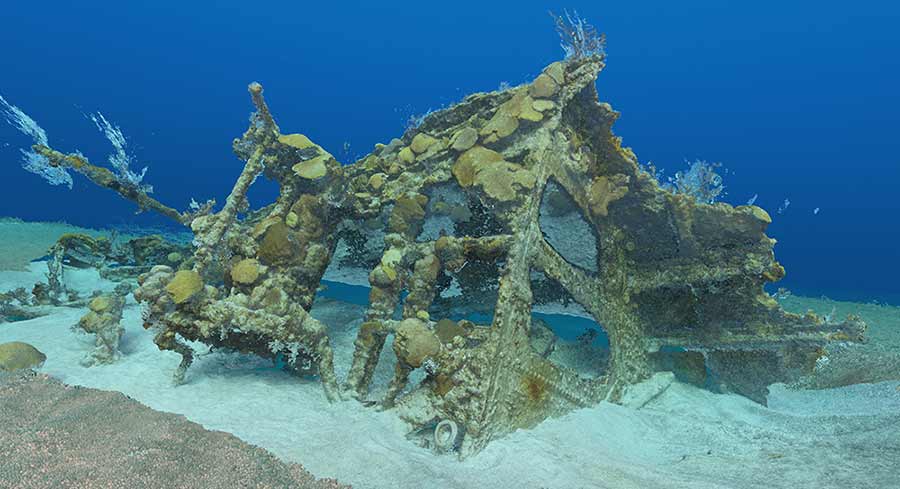
Still frame from 3D model of the bow of the Mary Celestia shipwreck
Bermuda’s Ministry of the Environment and the University of California San Diego have officially launched a first-of-its-kind effort to scan underwater shipwrecks and reef in three dimensions and at an unprecedented level of detail – while making the 3D environments accessible online to viewers worldwide. The project, known as the Bermuda 100 Challenge, pushes the frontier of engineering technology and showcases the fascinating marine history and beauty of Bermuda’s underwater landscape. The Bermuda 100 website (http://bermuda100.ucsd.edu) presents an exciting addition to the Ministry’s conservation, research and educational outreach program.
Now anyone can “dive” Bermuda’s culturally and historically significant wrecks from anywhere in the world. The goal is to map 100 wrecks and significant sites of natural beauty and ecological importance. The data will be used by marine scientists, historians, students, archaeologists and conservationists to monitor the wrecks and reef over time.
“It’s like having a massive, passive sensor network, precisely capturing longitude, latitude, depth and color of each underwater site,” said professor Falko Kuester, a computer scientist and structural engineer from UC San Diego’s Cultural Heritage Engineering Initiative (CHEI), who spearheaded the digital mapping effort.. “The data provide a baseline of as-is conditions that will allow scientists to study changes such as deterioration, sediment transport and coral growth.”
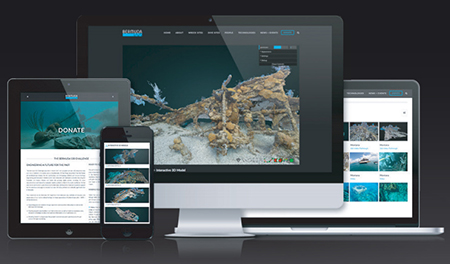
The Bermuda 100 website and its 3D interactive models of shipwrecks and coral reefs are accessible via smartphones, tablets, laptops and desktops.
To date, over four billion data points have been seamlessly stitched together using the latest technology to forge a complete ‘virtual reality’ experience. The interactive 3D model of Bermuda’s waters and four initial wreck sites is built from tens of thousands of photographs and, unlike a video, can be fully manipulated – allowing the viewer to navigate any site in every direction at their own pace. As additional shipwrecks are scanned, the overall data set will increase dramatically.
Dealing with so much data is a huge technical challenge in order to keep the viewer’s experience easy and fluid. The 4.3 billion data points have to be rendered and displayed 30 times every second, which means processing 133 billion data points per second. Further, if 3D goggles are involved, where data for the left and right eyes are rendered separately, the total number of data points doubles to 266 billion.
“Strong international partnerships in marine heritage and marine science have resulted in our small community taking bold and important, internationally recognized conservation steps,” said Robert Steinhoff, Chairman of Bermuda’s Historic Wrecks Authority. “Shipwrecks in Bermuda continue to have an important role to play in marine conservation – not least in attracting people into the ocean space. The partnership with UC San Diego will be a testbed for advanced virtual imaging technology and allows us to share our underwater museum with the world, and hopefully inspire a new generation of cultural and natural conservationists.”
Visitors to the America’s Cup Village in Bermuda this spring were among the first to see the technology in action. Two large digital displays in the Edu pavilion allowed visitors during the America’s Cup competition to fly between shipwreck sites and dive below the ocean surface to visit the four initial wreck sites.
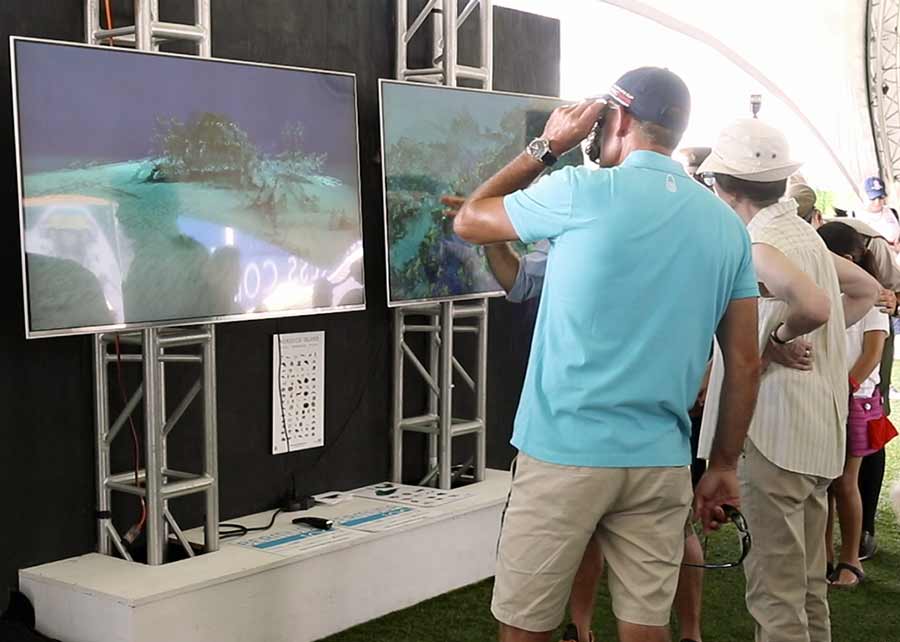
On race days, over 5,000 visitors passed through the America's Cup Village daily, where the educational pavilion treated visitors to virtual reality versions of four initial wreck sites in the Bermuda 100 database.
“It is now possible to experience Bermuda from the sky, dip below the surface to virtually explore the wrecks of the Montana and the Blanche King, swim to the Manilla while digitally labeling, extracting and evaluating its cannons, before traversing the wreck of the Mary Celestia,” said UC San Diego’s Kuester. “With the point-based visual analytics techniques developed by our team, it is possible to literally deep-dive into the existing four shipwrecks, accurately referenced within a 3D model of the island of Bermuda and its surrounding reefs. That said, this is one case where it is better experienced than described.”
The project was initiated when Jean-Pierre Rouja, a filmmaker and founder of LookBermuda and the Nonsuch Expeditions, and Dr. Philippe Rouja, Principal Scientist of Marine Heritage and Ocean Human Health and Custodian of Historic Wrecks for the Department of Conservation Services, connected with Prof. Kuester and his team from UC San Diego’s Qualcomm Institute. The result was the perfect combination of photography, shipwrecks and computer science to turn 2D photographs into 3D models.
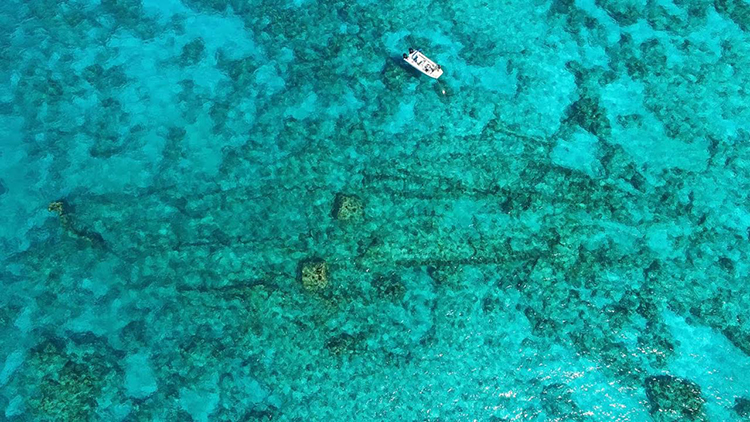
Aerial view of the Darlington shipwreck on coral reef with dive boat above
Bermuda has been at the center of Atlantic commerce for over 400 years. According to Philippe Rouja, “The four wrecks featured in the website are just a small portion of the wrecks around Bermuda but have been carefully chosen by the Historic Wrecks Authority for their aesthetic value, their historic significance and their diver-friendly aspects. The Department of Environment and Natural Resources needs to be commended for creating strong scientific partnerships that allow us to manage Bermuda’s abundant natural and cultural resources.” Fundamentally, he added, “the richer the stories we can tell and the more engaging and interconnected we can make our heritage, the easier it will be to preserve and manage it for future generations.”
“This is a perfect example of our ongoing efforts to combine high-quality media with the latest disruptive technologies to assist with cultural preservation, conservation and education,” said LookBermuda’s Jean-Pierre Rouja. “This portal allows scientists, students and the public at large not only to view but also to interact with these otherwise hard-to-access resources.”
According to UC San Diego’s Kuester, the Bermuda 100 Challenge could become the foundation for a global atlas of shipwreck sites and coral reefs on a global scale. “It would allow scientists, stakeholders and the public alike to explore and better understand these unique ecosystems, and contribute towards their preservation,” he explained. “This project pushes the envelope of science, technology and engineering in the context of robotic sensor platforms, imaging systems, 3D modeling, visualization and interactive data exploration.”
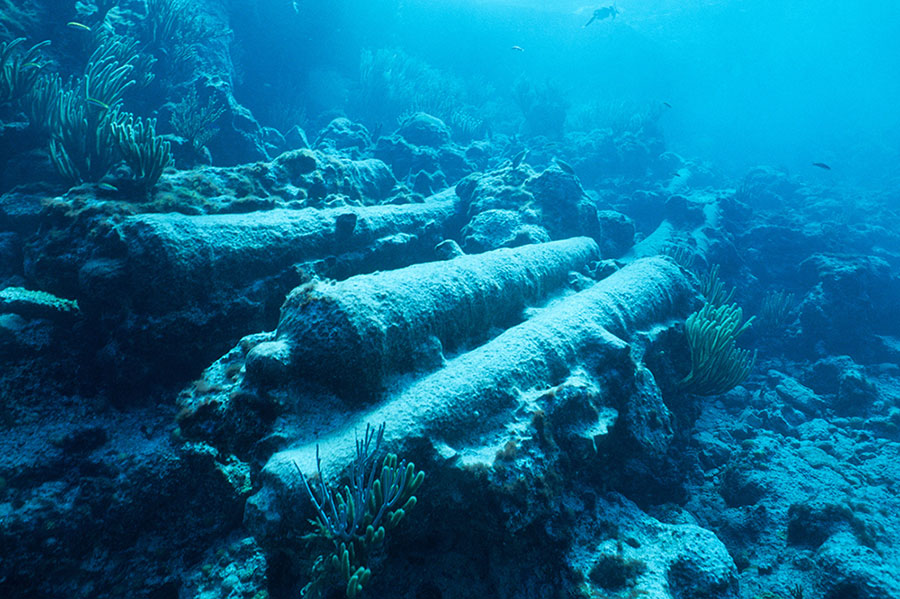
Guns are among all that is left at the Manilla wreck site dating to 1753.
For Bermuda’s Custodian of Historic Wrecks, the site could generate new enthusiasts. "For example, without the limits of a mask, tank and fins, we can share an image of an underwater airplane engine with plane enthusiasts and engineers and generate interest from sectors far beyond the diving fraternity,” said Philippe Rouja. “I have plans to create models of some of the more unique elements of our wreck sites— sites that are not open to the public— so the online community can give us the benefit of professional insights. For those who cannot travel or cannot dive, the 3D virtual experience is of particular value.”
The continued stewardship of Bermuda’s wreck sites is vitally important. Many wreck diving sites have dedicated mooring buoys installed and maintained through the generous long-term commitment of the Stempel Foundation to make access easier and protect the wrecks from anchor damage. These protected areas are also no-fishing sites. Diving these wreck sites is the highlight for many visitors to Bermuda and makes a substantial contribution to the tourism economy.
Just as cutting-edge technology played an important role in the America’s Cup competition that ended this week with a victory for Emirates Team New Zealand over two-time champion Oracle Team USA, technology is now making it possible for anyone with an Internet connection to fly around and dive underwater to tour shipwrecks and coral reefs that lie quietly beneath Bermuda’s turquoise water.
Keep up with all the latest from UC San Diego. Subscribe to the newsletter today.